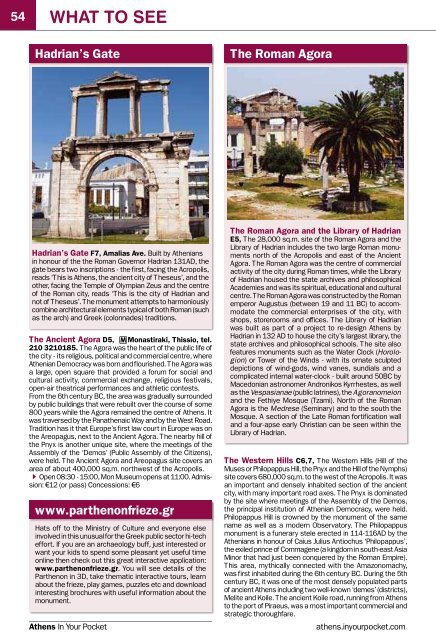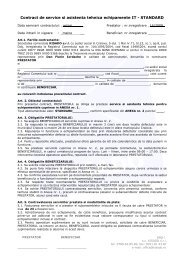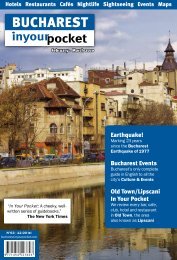Hotels Restaurants Cafés Nightlife Sightseeing Events Maps - KISADO
Hotels Restaurants Cafés Nightlife Sightseeing Events Maps - KISADO
Hotels Restaurants Cafés Nightlife Sightseeing Events Maps - KISADO
- No tags were found...
You also want an ePaper? Increase the reach of your titles
YUMPU automatically turns print PDFs into web optimized ePapers that Google loves.
54What to seeWhat to see55Hadrian’s GateThe Roman AgoraThe Parthenon Lysikrates MonumentHadrian’s Gate F7, Amalias Ave. Built by Atheniansin honour of the the Roman Governor Hadrian 131AD, thegate bears two inscriptions - the first, facing the Acropolis,reads ‘This is Athens, the ancient city of Theseus’, and theother, facing the Temple of Olympian Zeus and the centreof the Roman city, reads ‘This is the city of Hadrian andnot of Theseus’. The monument attempts to harmoniouslycombine architectural elements typical of both Roman (suchas the arch) and Greek (colonnades) traditions.The Ancient Agora D5, MMonastiraki, Thissio, tel.210 3210185. The Agora was the heart of the public life ofthe city - its religious, political and commercial centre, whereAthenian Democracy was born and flourished. The Agora wasa large, open square that provided a forum for social andcultural activity, commercial exchange, religious festivals,open-air theatrical performances and athletic contests.From the 6th century BC, the area was gradually surroundedby public buildings that were rebuilt over the course of some800 years while the Agora remained the centre of Athens. Itwas traversed by the Panathenaic Way and by the West Road.Tradition has it that Europe’s first law court in Europe was onthe Areopagus, next to the Ancient Agora. The nearby hill ofthe Pnyx is another unique site, where the meetings of theAssembly of the ‘Demos’ (Public Assembly of the Citizens),were held. The Ancient Agora and Areopagus site covers anarea of about 400,000 sq.m. northwest of the Acropolis.QOpen 08:30 - 15:00, Mon Museum opens at 11:00. Admission:€12 (or pass) Concessions: €6www.parthenonfrieze.grHats off to the Ministry of Culture and everyone elseinvolved in this unusual for the Greek public sector hi-techeffort. If you are an archaeology buff, just interested orwant your kids to spend some pleasant yet useful timeonline then check out this great interactive application:www.parthenonfrieze.gr. You will see details of theParthenon in 3D, take thematic interactive tours, learnabout the frieze, play games, puzzles etc and downloadinteresting brochures with useful information about themonument.Athens In Your PocketThe Roman Agora and the Library of HadrianE5, The 28,000 sq.m. site of the Roman Agora and theLibrary of Hadrian includes the two large Roman monumentsnorth of the Acropolis and east of the AncientAgora. The Roman Agora was the centre of commercialactivity of the city during Roman times, while the Libraryof Hadrian housed the state archives and philosophicalAcademies and was its spiritual, educational and culturalcentre. The Roman Agora was constructed by the Romanemperor Augustus (between 19 and 11 BC) to accommodatethe commercial enterprises of the city, withshops, storerooms and offices. The Library of Hadrianwas built as part of a project to re-design Athens byHadrian in 132 AD to house the city’s largest library, thestate archives and philosophical schools. The site alsofeatures monuments such as the Water Clock (Horologion)or Tower of the Winds - with its ornate sculpteddepictions of wind-gods, wind vanes, sundials and acomplicated internal water-clock - built around 50BC byMacedonian astronomer Andronikos Kyrrhestes, as wellas the Vespasianae (public latrines), the Agoranomeionand the Fethiye Mosque (Tzami). North of the RomanAgora is the Medrese (Seminary) and to the south theMosque. A section of the Late Roman fortification walland a four-apse early Christian can be seen within theLibrary of Hadrian.The Western Hills C6,7, The Western Hills (Hill of theMuses or Philopappus Hill, the Pnyx and the Hill of the Nymphs)site covers 680,000 sq.m. to the west of the Acropolis. It wasan important and densely inhabited section of the ancientcity, with many important road axes. The Pnyx is dominatedby the site where meetings of the Assembly of the Demos,the principal institution of Athenian Democracy, were held.Philopappus Hill is crowned by the monument of the samename as well as a modern Observatory. The Philopappusmonument is a funerary stele erected in 114-116AD by theAthenians in honour of Caius Julius Antiochus ‘Philopappus’,the exiled prince of Commagene (a kingdom in south-east AsiaMinor that had just been conquered by the Roman Empire).This area, mythically connected with the Amazonomachy,was first inhabited during the 6th century BC. During the 5thcentury BC, it was one of the most densely populated partsof ancient Athens including two well-known ‘demes’ (districts),Melite and Koile. The ancient Koile road, running from Athensto the port of Piraeus, was a most important commercial andstrategic thoroughfare.Parthenon E6, MAcropolis, tel. 210 3214172. Builtbetween 447-437BC, during the ‘Golden Age’ of Athensunder Pericles, the Parthenon is a world famous sight.Its design harmoniously combines the Doric and Ionicorders, and its architectural and structural details andthe precision in the carving of the marble are a testamentto the expertise in the artisans that created it. Further,the décor of the Parthenon and its surrounding monumentshad a profound and lasting influence on Westernart (especially sculpture and portraiture), as it depictedthe human form in an individualised manner for the firsttime. These artistic innovations fuelled developmentsthat influenced the art of Hellenistic and Roman times,as well as the Renaissance, Baroque, Romanticism andNeoclassicism. QOpen 08:30 - 15:00. Admission: €12,Concessions: €6 (four day pass)Panathenaic StadiumPanathenaic Stadium H7, Arditos Hill, tel. 2103251744. A Stadium existed on this site from as earlyas the 4th century BC, when it was used for the mysticalCeremonies held for the Panathenaic Festival in honourof Athena, patron-goddess of the City of Athens. Romangovernor Hadrian had also constructed a Stadium at thissite, where gladiatorial contests and shows were put on forthe Athenian public. The ancient Stadium was completelyrestored, as an exact replica of the Ancient Stadium, in thelate 19th century, in order to host the first modern Olympiad(1896). During the Athens Olympic Games of 2004, thisgleaming white Pentelic-marble Stadium provided the venuefor the archery event as well as for the culmination of theMarathon Run. Visitors can walk up to the Stadium but arenot allowed to enter its grounds.Lysikrates Monument F7, Lysicratous Square andTripodon St, Plaka, MSyntagma. This monument commemoratesthe support of its benefactor-founder of a theatricalperformance at the nearby theatre of Dionysus, theearliest theatre in the world - that’s the answer in case youwonder just what that strange structure on Tripodon Streetis. It was built in 335BC by Lysicrates and is also known asthe “Lantern of Diogenes” in reference to its unusual shape.The circular building rests on a square shaped limestonepodium and includes a portico of six Corinthian columns.It also has a frieze featuring the life of Dionysos, the god ofwine and revelry. In 1669, the structure was handed overto Capucin monks, who used it as a study room. The Lysicratesmonument is the best preserved of its kind, mainlydue to the efforts of French archaeologists Fr. Boulangetand E. Loviot who restored the area in 1887.Temple of Olympian ZeusTemple of Olympian Zeus F7, Vasilissis Olgas &Amalias, MAcropolis, tel. 210 9226330. Constructionof the temple began in the 6th century BC under the tyrantsHippias and Hipparchos, at the site of the ruins of an earliertemple built by their father, the tyrant Peisistratus. TheTemple stood unfinished throughout the ‘Golden Century’of Athens and was only completed by Roman governor Hadrian,known as the ‘Philhellene’, in 132AD. The Temple washuge by ancient standards, rivalling other colossal famousTemples such as the Heraion in Samos, and featured a largegold and ivory statue of Zeus in its cella. Today, only fifteenof its original 104 columns are still standing. A sixteenthcolumn lies on the ground, where it fell during a storm inthe 19th century. QOpen 08:30 - 15:00. Admission: €2,Free for pass holders.A four day pass costing €12 (concessions €6) will getyou in: The Acropolis, the Ancient Agora & museum,Kerameikos & museum, the Roman Agora, Acropolis’North & South Slopes and the Temple of Olympian Zeus.athens.inyourpocket.com athens.inyourpocket.com February - March 2010








